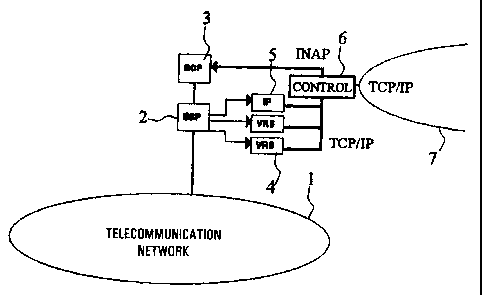Some of the information on this Web page has been provided by external sources. The Government of Canada is not responsible for the accuracy, reliability or currency of the information supplied by external sources. Users wishing to rely upon this information should consult directly with the source of the information. Content provided by external sources is not subject to official languages, privacy and accessibility requirements.
Any discrepancies in the text and image of the Claims and Abstract are due to differing posting times. Text of the Claims and Abstract are posted:
| (12) Patent: | (11) CA 2317771 |
|---|---|
| (54) English Title: | INTELLIGENT NETWORK |
| (54) French Title: | RESEAU INTELLIGENT |
| Status: | Expired and beyond the Period of Reversal |
| (51) International Patent Classification (IPC): |
|
|---|---|
| (72) Inventors : |
|
| (73) Owners : |
|
| (71) Applicants : |
|
| (74) Agent: | SMART & BIGGAR LP |
| (74) Associate agent: | |
| (45) Issued: | 2005-03-29 |
| (86) PCT Filing Date: | 1999-01-05 |
| (87) Open to Public Inspection: | 1999-07-15 |
| Examination requested: | 2000-07-05 |
| Availability of licence: | N/A |
| Dedicated to the Public: | N/A |
| (25) Language of filing: | English |
| Patent Cooperation Treaty (PCT): | Yes |
|---|---|
| (86) PCT Filing Number: | PCT/EP1999/000152 |
| (87) International Publication Number: | WO 1999035859 |
| (85) National Entry: | 2000-07-05 |
| (30) Application Priority Data: | ||||||
|---|---|---|---|---|---|---|
|
Intelligent network (IN), comprising at least one Service Switching Point, SSP
(2), at least one Service Control Point, SCP (3), one
or more Intelligent Peripherals, IPs (5), and/or one or more Voice Response
Systems, VRSs (4), which IN is capable of interacting with
a PSTN or ISDN (1). The essence of the concept is an additional interface, in
the form of a control member (6), between the IPs and/or
VRs on one side and the Service Control Points) on the other side. Such makes
it possible that the (advanced) IPs and VRSs are capable
of exchanging all sorts of information with the SCP, without the IPs or VRSs
consequently being occupied for an extended period of time.
As a result, the SCP may dispose of (additional) information which in a
regular IN cannot be mere available to the SCP(s).
L'invention concerne un réseau intelligent (IN) comprenant au moins un point de commutation d'accès aux services SSP (2), au moins un point de commande de services SSP (3), un ou plusieurs périphériques intelligents IP (5), et/ou un ou plusieurs systèmes de réponse vocale VRS (4), ce réseau intelligent pouvant interagir avec un réseau téléphonique commuté public ou un réseau ISDN (1). L'essence du concept présenté réside dans une interface additionnelle se présentant sous la forme d'un organe de commande (6) placé entre les périphériques intelligents et/ou les systèmes de réponse vocale, d'une part, et le ou les points de commande de services, d'autre part. Grâce à cet agencement, les périphériques intelligents et les systèmes de réponse vocale (avancés) peuvent échanger n'importe quel type d'informations avec le ou les points de commande de services, cela sans que les périphériques intelligents ou les systèmes de réponse vocale soient occupés pendant une longue période. Ainsi, le ou les points de commande de services peuvent disposer d'informations (additionnelles) dont ils ne pourraient pas disposer dans un réseau intelligent classique.
Note: Claims are shown in the official language in which they were submitted.
Note: Descriptions are shown in the official language in which they were submitted.

2024-08-01:As part of the Next Generation Patents (NGP) transition, the Canadian Patents Database (CPD) now contains a more detailed Event History, which replicates the Event Log of our new back-office solution.
Please note that "Inactive:" events refers to events no longer in use in our new back-office solution.
For a clearer understanding of the status of the application/patent presented on this page, the site Disclaimer , as well as the definitions for Patent , Event History , Maintenance Fee and Payment History should be consulted.
| Description | Date |
|---|---|
| Time Limit for Reversal Expired | 2016-01-05 |
| Letter Sent | 2015-01-05 |
| Grant by Issuance | 2005-03-29 |
| Inactive: Cover page published | 2005-03-28 |
| Inactive: Final fee received | 2004-11-08 |
| Pre-grant | 2004-11-08 |
| Notice of Allowance is Issued | 2004-10-06 |
| Letter Sent | 2004-10-06 |
| Notice of Allowance is Issued | 2004-10-06 |
| Inactive: Approved for allowance (AFA) | 2004-09-28 |
| Amendment Received - Voluntary Amendment | 2004-08-23 |
| Inactive: S.30(2) Rules - Examiner requisition | 2004-04-06 |
| Amendment Received - Voluntary Amendment | 2002-12-03 |
| Inactive: S.30(2) Rules - Examiner requisition | 2002-06-03 |
| Inactive: Cover page published | 2000-10-18 |
| Inactive: First IPC assigned | 2000-10-15 |
| Inactive: Acknowledgment of national entry - RFE | 2000-09-28 |
| Letter Sent | 2000-09-28 |
| Application Received - PCT | 2000-09-26 |
| All Requirements for Examination Determined Compliant | 2000-07-05 |
| Request for Examination Requirements Determined Compliant | 2000-07-05 |
| Application Published (Open to Public Inspection) | 1999-07-15 |
There is no abandonment history.
The last payment was received on 2004-12-21
Note : If the full payment has not been received on or before the date indicated, a further fee may be required which may be one of the following
Please refer to the CIPO Patent Fees web page to see all current fee amounts.
Note: Records showing the ownership history in alphabetical order.
| Current Owners on Record |
|---|
| KONINKLIJKE KPN N.V. |
| Past Owners on Record |
|---|
| HARRY VAN BARNEVELD |
| JOOST ADRIAANSE |
| LAURENTIUS JOSEPHUS MARIA VLEER |
| PAUL RIETKERK |